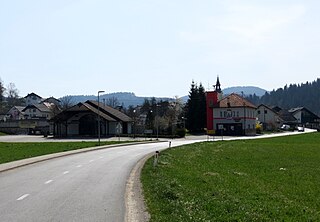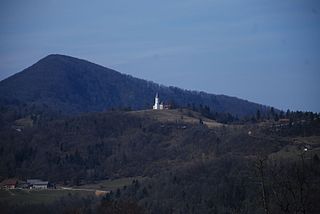
Šentjur is a town in eastern Slovenia. It is the seat of the Municipality of Šentjur. The town lies on the Voglajna River east of Celje. The area was part of the traditional region of Styria. The municipality is now included in the Savinja Statistical Region.
Sveti Jurij, meaning 'Saint George', sometimes abbreviated to Sv. Jurij, may refer to a number of settlements in Slovenia:

Loka pri Zidanem Mostu is a village on the left bank of the Sava River in the Municipality of Sevnica in central Slovenia. The area is part of the historical region of Styria. The municipality is now included in the Lower Sava Statistical Region.

Sveti Jurij is a settlement in the Municipality of Rogatec in eastern Slovenia. It lies northeast of the town of Rogatec, east of Donačka Gora, and south of Mount Saint Donatus. It is sometimes known as Sveti Jurij pri Donački Gori to differentiate it from other settlements with the same name. The entire Rogatec area traditionally belonged to the Styria region. It is now included in the Savinja Statistical Region.

Planinska Vas is a small village in the Municipality of Šentjur in eastern Slovenia. It lies in the Sava Hills east of Planina pri Sevnici. The area is part of the historical Styria region. The municipality is now included in the Savinja Statistical Region.

Šent Jurij is a village in the Municipality of Grosuplje in central Slovenia. The area is part of the historical region of Lower Carniola. The municipality is now included in the Central Slovenia Statistical Region.

Šentjurje is a small settlement to the east of Šentvid pri Stični in the Municipality of Ivančna Gorica in central Slovenia. The area is part of the historical region of Lower Carniola. The municipality is now included in the Central Slovenia Statistical Region.

Čelovnik is a dispersed settlement in the hills north of Loka pri Zidanem Mostu in the Municipality of Sevnica in central Slovenia. The area is part of the historical region of Styria. The municipality is now included in the Lower Sava Statistical Region.

Kal pri Krmelju is a small settlement in the Municipality of Sevnica in central Slovenia. The area is part of the historical region of Lower Carniola. The municipality is now included in the Lower Sava Statistical Region.

Kaplja Vas is a village in the Municipality of Sevnica in central Slovenia. The area is part of the historical region of Lower Carniola. The municipality is now included in the Lower Sava Statistical Region.

Okroglice is a settlement in the hills northeast of Loka pri Zidanem Mostu in the Municipality of Sevnica in east-central Slovenia. The area is part of the historical region of Styria. The municipality is now included in the Lower Sava Statistical Region.

Radež is a settlement in the hills above the left bank of the Sava River in the Municipality of Sevnica in east central Slovenia. The area is part of the historical region of Styria. The municipality is now included in the Lower Sava Statistical Region.

Račica is a settlement east of Loka pri Zidanem Mostu on the left bank of the Sava River in the Municipality of Sevnica in east-central Slovenia. The area is part of the historical region of Styria. The municipality is now included in the Lower Sava Statistical Region.

Rovišče pri Studencu is a nucleated settlement in the Municipality of Sevnica in central Slovenia. The area is part of the historical region of Lower Carniola. The municipality is now included in the Lower Sava Statistical Region.

Slap is a small settlement above the left bank of the Sava River north of Loka pri Zidanem Mostu in the Municipality of Sevnica in east-central Slovenia. The area is part of the historical region of Styria. The municipality is now included in the Lower Sava Statistical Region.

Žirovnica is a small settlement in the hills north of Loka pri Zidanem Mostu in the Municipality of Sevnica in east-central Slovenia. The area is part of the historical region of Styria and is now included in the Lower Sava Statistical Region with the rest of the municipality.

Trnovec is a settlement in the hills northeast of Sevnica in east-central Slovenia. The area is part of the historical region of Styria. The Municipality of Sevnica is now included in the Lower Sava Statistical Region.

Telče is a settlement east of Tržišče in the Municipality of Sevnica in east-central Slovenia. The area is part of the historical region of Lower Carniola. The municipality is now included in the Lower Sava Statistical Region.

















